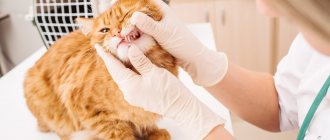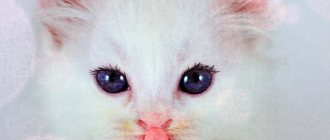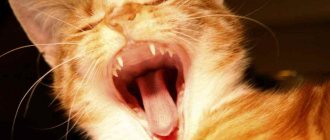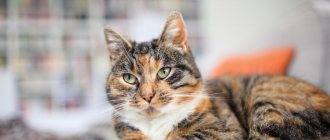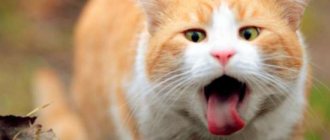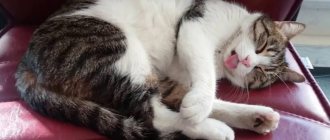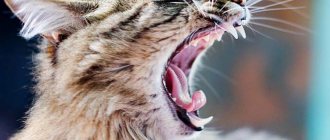Deposits on the surface of teeth in animals and people of calcareous origin form tartar. Growths on teeth contain a whole mixture of substances of organic and inorganic origin (usually phosphates and calcium carbonate), as well as a large number of bacterial microorganisms.
Tartar can be yellow in color, sometimes reaching a dark brown color. The shade of limescale deposits on teeth is determined by the type of food entering the animal’s body, bacteria, microelements, and phosphorus salts.
Lack of teeth. Is it harmful for cats?
Not all owners take proper care of their pets.
It happens that veterinarians have to remove teeth because treatment is simply useless. Of course, complete absence of teeth can be frightening for a cat owner. It seems that it will be very difficult for the pet to eat, and starvation is already close. In fact, the situation is not as hopeless as it might seem at first glance. In nature, felines need teeth to perform a lethal chokehold on their prey. They do not use them to chew food. They need their teeth in order to tear their prey to shreds and then simply swallow the piece whole. A cat’s digestive system is designed in such a way that it can digest food just fine.
Modern ready-made cat food is soft, so even without teeth the pet will easily get enough. Domestic cats do not need to hunt. Meals are delivered to your home. But, despite the fact that the toothless cats are threatening me with starvation, it’s not worth letting the situation get to that extent.
If you notice that your cat’s teeth are falling out, and there are no natural reasons for this, then you urgently need to consult a veterinarian. The specialist will determine the cause, make a diagnosis, and prescribe treatment. As a rule, dentistry for cats consists of two parts. Firstly, these are procedures performed by a doctor in a veterinary clinic. Secondly, further care falls on the shoulders of the animal owner.
At the clinic, they can give you an intramuscular injection of antibiotics, give you special tablets for inflammation, and rinse your mouth with special solutions. In more complex cases, surgical operations are performed.
Teeth indicate a cat's age
The correct structure and the absence of any pathological signs generally indicate the health of the oral cavity. In addition, by looking into the animal's mouth, you can find out the cat's age by its teeth. Determining how old or young a pet is is quite simple, being aware of some nuances:
- The furry baby is apparently not even a month old, if his incisors have just begun to erupt.
- In an older kitten, the beginning of the process of losing baby teeth indicates that he is approximately 3-4 months old.
- If a kitten already has a full set of 30 teeth, it is probably at least six months old.
- An adult one-year-old animal has a snow-white grin and practically no plaque.
- By the age of two, the lower central incisors of cats begin to wear off, the enamel noticeably turns yellow, and the first tartar appears.
- At five years old, pets already have fairly worn out upper incisors and mandibular canines.
- After another couple of years, pigmentation occurs on the surface of the enamel.
- By the age of 10, cats' incisors often fall out.
- In older animals - 15 years and older - even their fangs fall out.
The structure of the teeth does not always allow one to accurately determine how old a cat is. Sometimes improper oral care of an animal or lack of it at all leads to the fact that the pet’s dental system begins to age prematurely. Periodic brushing of teeth and a balanced diet will help your cat maintain a satisfactory level of oral health and prevent the development of diseases.
What treatment is prescribed?
How to treat with drugs?
A veterinarian treats a cat’s sick and yellow teeth. Conservative therapy is carried out at the initial stages of the disease, its main goals are:
- eliminate inflammation;
- destroy the infection;
- relieve pain;
- prevent the spread of the pathological process.
Effective treatment involves the use of the following groups of drugs:
In some situations, prescribing antibacterial therapy to an animal is justified.
- antibiotics;
- antiseptics;
- non-steroidal anti-inflammatory drugs;
- painkillers;
- vitamins and immunorestoratives.
The following dental ointments help fight inflammation and swelling:
- "Metrogil Denta";
- "Dentavidin";
- "Nibbler."
Surgery
If the disease is advanced, the tooth has become black and cannot be treated conservatively, it is removed, and the wound is treated with an antiseptic solution. After surgery, it is necessary to monitor the health of the oral cavity, carry out antibacterial irrigation, and take antibiotics to prevent infectious inflammation.
DO CATS TEETH HURT?
Most often this happens due to the animal’s unhealthy diet, poor lifestyle, and there may also be a disease of the internal organs. In any case, if a cat has dental problems, you must contact a veterinarian for a diagnosis and treatment. There are special medicinal lines of food for the oral cavity.
DENTAL PROBLEMS IN CATS: SYMPTOMS
If a cat has toothache, he will certainly let you know about it. Dental diseases in cats are manifested by the following symptoms:
- the cat rubs its cheek with its paw or rubs against objects;
- gums become inflamed and swollen;
- Bad breath may appear;
- partial or complete loss of appetite;
- possible darkening of teeth;
- the cat is acting restless;
- increased salivation.
DENTAL DISEASES IN CATS
What types of dental diseases do cats have?
- caries
- osteomyelitis
- pulpitis
- periodontium
- stones on teeth
- and etc.
Only a veterinarian can make a correct diagnosis. Also, the condition of a cat’s teeth is an indicator of the animal’s health. Often, timely care for a kitten and an adult cat will help to avoid many problems in the future.
THE CAT HAS PALQUET ON THE TEETH
Plaque on a cat’s teeth appears when the pet is 1.5 years old.
As a rule, when a cat has a cat, this does not cause any inconvenience to the animal, but if the cat still shows anxiety, you just need to brush his teeth, it is enough to do this once a week.
THE CAT HAS YELLOW TEETH
If a cat has yellow teeth, this is primarily an indication of insufficient dental care. Now there are many treats for cats, which, when eaten and chewed, mechanically clean the teeth. If a cat's teeth turn yellow with age, then, in principle, this is the norm. A cat's teeth become yellow after 3-5 years.
STONES ON THE TEETH OF CATS
Stones on the teeth of cats can appear both with age and with insufficient good care of the pet. If we are talking about a minor manifestation, an excellent way to combat and prevent it is to brush your cats’ teeth. If this is an already advanced case, you need to go to a veterinary clinic and have the teeth cleaned of tartar, especially if this causes inconvenience to the pet.
THE CAT'S TEETH ROTS
If your cat's teeth are rotting, then first of all you need to undergo an examination by a specialist. Remove completely bad teeth, put fillings on those that still need to be treated, clean your teeth and try to prevent reoccurrences. It also often happens that if a cat has rotten teeth - this is evidence of certain diseases, you should definitely contact a veterinarian; the cat may need additional treatment. If one of your cat’s teeth is rotting, treat it and provide prevention.
BLACK TEETH IN A CAT
Black teeth in a cat most often indicate the presence of caries or pulpitis, which can be treated by simply installing a filling. If, in addition to a black tooth, the cat has additional symptoms, a veterinary dentist will make an accurate diagnosis.
INFLAMMATION OF TEETH IN CATS
Dental inflammation in cats is quite common and is usually the cause of gingivitis and stomatitis. If gum inflammation in cats is not treated, periodontal disease may develop. If your cat's teeth are bleeding quite heavily and red, swollen gums are visible, contact your veterinarian immediately. To avoid complications and further inflammation, you need to brush your teeth and remove tartar.
HOW TO TREAT A CAT'S TEETH?
You can treat a cat’s teeth only in cases where this is the very first stage, and the most you can do is brush the cat’s teeth and rinse the gums with oak bark tincture. Dental treatment for cats, as a rule, requires the skills of a specialist who will correctly diagnose, prescribe treatment or remove a cat’s tooth. A cat's teeth must be treated under general anesthesia.
Anesthesia for ultrasonic teeth cleaning is used because the animal will be frightened by the sound of the device, and the oral cavity will not be able to open as much as necessary to clean the painters’ distant teeth. Under anesthesia, the animal relaxes and all teeth can be reached without problems. You can’t explain to a cat that you need to be patient and your teeth will be healthy. Arriving at the clinic is stressful, and then there’s the unfamiliar procedure.
Before anesthesia, a blood test will be taken from the animal and an ultrasound of the heart will be performed.
This is especially important for the following breeds - British, Scottish fold, Maine Coon and the like. If everything is fine with the tests and ultrasound, then the procedure can be carried out; if there are questions, the veterinarian must explain everything, cancel or reschedule the teeth cleaning
Cleaning lasts from 30 to 60 minutes. The animal must not be fed 12 hours before the procedure, and water must not be given 1 hour before the procedure.
| In our nursery you can “buy a real British kitten.” We have many different colors, we will help you choose and answer all your questions! |
Diagnostic methods
To make the correct diagnosis
For your “yellowed” pet, the veterinarian will definitely interview you in detail about the cat’s condition, nutrition, and behavior. Then he will prescribe laboratory tests such as blood biochemistry, blood sugar, coagulogram, general blood test, tests for viral infections, toxoplasmosis, parasitic infestations, and urinalysis. An ultrasound and x-ray may be necessary. Sometimes a liver biopsy is required. Thanks to these tests, the doctor will reveal where the “culprit” of jaundice is hiding and determine the disease. Having made a prompt diagnosis, a veterinarian will most likely be able to cure jaundice in a cat.
Causes of periodontal disease
One animal may have several reasons for its dental problems.
Lack of oral hygiene
Simply put, the cat does not brush its teeth. Over the course of life, teeth become increasingly covered with soft plaque. Plaque is 80% a bacterial colony. The remaining 20% is the epithelium of the oral cavity, saliva, and food particles. When saturated with calcium salts, plaque turns into tartar - a hard brown mass that cannot be removed with any brush.
The waste products of bacteria trigger a strong inflammatory process in the gums (gingivitis). The gums gradually “dissolve”, move away, and pockets and subgingival tartar form. Periodontal pockets are already a sign of destruction of the jaw bone around the tooth.
The older the cat, the greater the likelihood of developing periodontitis.
Infectious diseases
Inflammation of the gums and mucous membranes of the oral cavity (gingivostomatitis) is sometimes caused by viral diseases of cats:
- immunodeficiency (FIV) and leukemia (FeLV);
- calicivirus;
- rhinotracheitis (herpes virus).
If left untreated, gingivitis gradually progresses to periodontitis.
Non-communicable systemic diseases
- Diabetes. Diabetes inhibits the healing of any tissue, including those destroyed by infection. Decreased immunity in diabetic cats provokes increased proliferation of bacteria in the oral cavity.
- Kidney failure. Toxic products of protein metabolism are not excreted by the kidneys and begin to be released in the form of ammonia through the mucous membranes, corroding them. In older cats, you can see not only severe inflammation of the gums, but also ulcers on the tongue and cheeks.
- Irregularity of teeth. It is found in certain breeds - Persians, Exotics, British. Flat-faced (brachiocephalic) cats have a jaw that is too short to accommodate the natural number of teeth. As a result, the teeth are crowded, crooked and at random. They cannot be cleaned naturally and quickly become overgrown with tartar. Teeth can grow unnaturally for other reasons: jaw fracture, malocclusion (overshot, undershot).
- Genetic predisposition. Some cats can live 15-20 years without serious dental problems. In others, massive tartar and loss of molars are observed as early as 8-12 years of age. When this cannot be attributed to other factors, it is obvious: dental and oral health can be inherited.
Improper feeding
Eating only soft foods does not put stress on the teeth when chewing. In animals, teeth must work, this strengthens the ligament of the tooth and gum tissue. Wet canned food or cereal accumulates on teeth, accelerating the development of tartar. Soft food does not clean teeth mechanically, as happens when chewing cartilage or dry food granules. The composition of the feed itself is also important.
Oral diseases: list and characteristics
Cats suffer most from gum disease that develops as a result of feeding poor quality food. Symptoms: hyperemia, swelling, ulcers, similar to signs of scurvy.
Inflammation of the gums.
A strong odor from the mouth indicates tartar, an accumulation of food particles between the teeth. During the inflammatory process, there is a danger of tooth decay and the development of periodontitis.
Upon examination, reddened, swollen gums are visible, painful with areas of bleeding. If left untreated, the gums gradually recede from the tooth, forming pockets in which food accumulates. Putrefactive inflammation, caries, and periodontitis develop. The cat refuses to eat, becomes weaker, has unkempt fur, and saliva may flow from its mouth.
Inflammation of the tongue.
Infectious pathology, glossitis, indicates immunodeficiency conditions, feline leukemia, acute respiratory disease, viral immunodeficiency syndrome. Sometimes the inflammatory process appears when exposed to external factors, licking highly irritating substances. Symptoms: profuse salivation, sometimes foamy, anorexia, pain. Externally, the cat looks unkempt. After healing and disappearance of the inflammatory process, the surface of the tongue is smoothed, it becomes varnished, smooth without a hard brush. Erosion and ulcers often form.
Stomatitis.
Oral disease is manifested by severe salivation and inflammation of the mucous membrane. The cat refuses to eat, inspection of its mouth is difficult, it rubs its face with its paws and shakes its head.
Redness and swelling are noticeable on the mucous membrane, gums bleed, and there is a strong odor from the mouth. The cat seems to be “ruffling up”, looking unkempt and disheveled. In young cats, candidiasis (thrush) is diagnosed; the disease becomes more pronounced when treated with antibiotics, steroids, with low immunity, or after a serious illness. Symptoms of thrush: a whitish film on the tongue, gums; if left untreated, ulcers form on the mucous membrane.
Pharyngitis.
This is a rare disease of the oral cavity, occurring as a secondary pathology against the background of a viral infection, diseases of the mouth and pharynx. With pharyngitis, the temperature rises, pain, cough, and nausea appear. No appetite.
Tonsillitis.
Inflammation of the tonsils is rarely diagnosed in cats. Hyperthermia (above 39.4C), lethargy, and anorexia are observed. The underlying cause of the disease is a bacterial infection.
In case of recurrent tonsillitis, removal of the tonsils is indicated, since greatly enlarged tonsils interfere with the normal passage of air into the lungs, cause attacks of suffocation, and interfere with food intake.
Neoplasms of the salivary glands.
Cysts and tumors form under the influence of external factors. As a rule, the salivary gland is damaged in cat fights, when a foreign object enters. The accumulating fluid ruptures the duct and a cyst is formed - a mucocele.
The submandibular gland is most often affected; when palpated under the tongue, a smooth, large cyst can be detected. Neoplasms disturb the animal, making it difficult to breathe and swallow. More often, complete removal of the damaged salivary gland is required; punctures and rinses do not give the desired effect.
In older cats, tumors are (usually) malignant and appear as hard, slow-growing lumps on the side of the face or neck.
Foreign bodies.
Needles, bones, fragments, chips, thorns, threads get into the oral cavity. The specific structure of the tongue with papillae curved inwards does not allow a foreign object to fall out. It is easy for a breeder to understand that something has got into the cat’s mouth; she shakes her head, meows, and tries to reach with her paws what is bothering her. Severe drooling, restlessness, refusal to eat.
Particularly dangerous are the bones from fish, which dig into the soft tissues of the mouth and pharynx and “sit” there without causing signs of concern. After a few days, the bone rots, a strong odor from the mouth appears, intoxication, weakness, and apathy develop. If the outcome is successful, the bone comes out with a ruptured abscess and pus.
Jacobs ulcer.
It is found in the middle of the upper lip, sometimes on the lower or oral mucosa. It looks like a yellow or reddish shiny spot that turns into a weeping erosion without pain or itching. Diffuse growth: the ulcerated surface increases, teeth and gums are exposed. Jacobs ulcer has a tendency to develop into cancer or fibrosarcoma. The cause of the pathology is not clear; a connection is suggested with dental infections and the feline leukemia virus.
Caring for your cat's teeth
It is useful to sometimes look into the mouth of a domestic animal for a general assessment of the condition of the teeth and oral cavity as a whole, even if outwardly there is no hint of problems with the chewing apparatus. There are no special conditions for caring for a cat’s oral cavity, other than proper nutrition in accordance with age.
Advanced case of tartar in a cat
One of the most common problems with cat teeth is tartar. In nature, predators do not have this problem. Pets who receive dry food or food in large pieces do not have it either. With regular feeding of soft foods, when the procedure of self-cleaning of the oral cavity is excluded, plaque forms on the teeth, which under the influence of bacteria, salts and food debris turns into tartar. The launched process will require cleaning with special tools in veterinary clinics and under anesthesia.
To prevent this problem you should:
- brush cats’ teeth at home with special brushes with rubber (silicone) fingertips at least once every 3-4 weeks;
- periodically feed with special dry food for self-cleaning of teeth;
- Do not feed soft food in the form of small pieces.
For preventive sanitation of the oral cavity in cats, as well as to prevent the formation of plaque and tartar, as prescribed by a veterinarian, you can use the drug “Stomadex” C100 in courses of 10 days (cost: 400-450 rubles/pack with 10 tablets). The tablet from the package is glued with your finger onto the dry surface of the cheek closer to the toothless edge (top or bottom). Dry the cheek with a clean, dry paper towel. After attaching the tablet, the animal should not be given food or drink for 20-25 minutes. It is better to do the procedure before bed, half an hour after the last feeding (the period when the amount of saliva produced decreases).
Toothbrush for a cat
To clean your teeth, you can use special mixtures sold in pet stores or veterinary pharmacies or prepare it yourself (½ teaspoon of soda without top is moistened with red wine to the consistency of a paste and used to clean premolars and molars). The use of human cleaning pastes on cats is prohibited!
The formation of the chewing apparatus in cats occurs according to the general laws of animal physiology and does not require human intervention. But this does not exempt owners of fanged pets from monitoring this process and preventive examination of the oral cavity.
https://prohvost.club/koshki/fiziologiya-koshek/kogda-menyayutsya-molochnyie-zubyi-u-kotyat.htmlhttps://vetvo.ru/%D1%81%D0%BC%D0%B5%D0%BD %D0%B0-%D0%B7%D1%83%D0%B1%D0%BE%D0%B2-%D1%83-%D0%BA%D0%BE%D1%88%D0%B5%D0% BA.htmlhttps://zoosecrets.ru/kogda-u-koshek-menyayutsya-molochnye-zuby-na-postoyannye/
Diet therapy
Dental health problems occur in animals fed soft or liquid diets. To prevent the occurrence of diseases, you need to give your pet the right diet.
Water. The pet must have constant access to fresh, clean water. Ready-made food is also a source of liquid, the percentage composition depends on the type of food.
Proteins. Cats are carnivores by nature, so their diet must contain animal proteins.
Carbohydrates. During experimental observations of domestic animals, the positive effect of fiber on the body was revealed. The long fibers act as a natural toothbrush, massaging and cleaning the oral cavity.
Minerals. Microelements containing calcium and phosphorus are needed by the animal body in limited quantities. A lack of calcium leads to the destruction of bone tissue, and excess calcium is deposited in the form of dental stone.
Vitamins A, B, C , D. Lack of vitamins leads to problems: inflammation and degeneration of dental tissue and oral cavity. To avoid the development of progressive diseases, the pet must receive vitamins in the required quantities. The best balance of vitamins and minerals is found in factory-made feed. For food prepared at home, maintaining the correct balance of microelements is almost impossible.
Dental diets
Simple dry food is not able to provide complete care for an animal’s teeth. The cat bites through the granules using the tops of the teeth, and to fully clean the mouth, contact is needed over the entire surface of the dentition.
Modern animal nutrition developers pay attention to the selection of the shape, size and texture of pelleted food in order to obtain the optimal ratio for the health of cats. The saturation with microscopic fibers makes the nutrition as close as possible to what exists in nature. The individual granules are coated with layers of a substance that reduces the calcium content in the animal's saliva.
Numerous experiments have confirmed the effectiveness of such a diet in preventing problems and maintaining the animal’s oral cavity in a healthy state.
Impression of dentures
It happens that manufacturers of toys for pets (sticks for cats) advertise their product as a means to prevent oral diseases. This is generally not true. The cat owner should avoid toys:
- made of hard material that scratches the enamel surface;
- from ropes (to avoid dislocation of the jaw when playing);
- made of thin, tearable fabric that an animal can tear and swallow in pieces.
The size of the toy should be selected in such a way that the animal does not swallow the object whole and does not dislocate its jaws when playing (if the object is too large).
Cat dental care primarily involves regular brushing. The animal cannot talk about pain, so the first symptoms of problems usually go unnoticed and later lead to complications. It is possible to properly clean dental calculus only under general anesthesia in a veterinary clinic (tartar removal surgery).
What do cat teeth and gums normally look like?
Like most mammals, cats have 2 sets of teeth - milk and permanent. Kittens are born toothless, but after a few days they begin to cut their first milk teeth.
The change from a temporary set to a permanent one begins 6–8 weeks after birth. This is a gradual process, so for most owners it goes unnoticed, given the small size of the teeth. By 8 months, all baby teeth should be replaced by molars. Since cat saliva contains the enzyme lysozyme, which has an antibacterial effect, the change occurs painlessly.
An adult cat normally has 30 teeth: 16 in the upper jaw and 14 in the lower jaw. There is a congenital feature - oligodontia, which is inherited, in which the dental set is incomplete.
The structure of the teeth is determined by the diet of cats. Cats are predatory animals; they use their teeth to hold prey and tear meat. Description of the dental kit:
- Incisors. Small teeth that are located in the front of both jaws, 6 pieces on each. Unlike herbivores and omnivores, the cat does not bite off food with them; they serve to hold pieces of food.
- Fangs. The longest and sharpest teeth, 2 fangs on both sides on each jaw. They have the deepest root canals. Designed to kill prey - with them the cat bites through the area near the victim's spine, damaging the spinal cord, and with them it tears off pieces of food.
- Premolars. The 6 upper and 4 lower molars are designed for grinding dense foods, such as meat.
- Molars. 4 molars on both jaws. Also used for chewing food.
Cat's dental system
How many teeth a cat has is a question that interests many owners. Pets are born toothless. The first incisors are cut around the 2nd week of life. Then the canines and molars grow. They are cut from the pet until the end of the 1st month of life. In total, the kitten develops 26 teeth, of which 14 are on the upper jaw, and 12 on the lower jaw.
Milk teeth in cats, like in humans, are replaced by permanent teeth. This process begins at the age of 4 months. The change of teeth in cats is completed at 8 months. 4 additional teeth also grow, and there should be 30 in total (16 on the upper jaw and 14 on the lower jaw). The arrangement of a cat's teeth is quite simple. The dental system of an adult pet includes:
- incisors, located in the front and used to capture prey;
- fangs designed for tearing prey;
- premolars involved in chewing food;
- molars, which are also involved in grinding food.
Internal illnesses
Various lesions of the oral cavity can cause tooth loss in cats of any age. These can be pulpitis, periodontitis, tartar, gingivitis and stomatitis.
Pulpitis is an inflammation of the soft inner part of the tooth. It develops more often due to the breaking off of part of the tooth crown. Caries is practically never found in cats, because they do not have a love for sweets. Carious microbes require sugar and an acidic environment to live.
Periodontitis in humans is often called inflammation of the tooth root. In cats, this term refers to inflammation of the ligaments that hold the tooth in the socket of the jaw. With this disease, the ligaments easily tear off and the tooth falls out.
The development of tartar occurs due to the accumulation of dental plaque. Normally, most cats, even fifteen years old, have only a slight brownish coating on their teeth. However, in some individuals, deposits build up very quickly on their teeth, which become compressed and become very hard. Over time, such a stone moves the gum away from the neck of the tooth, and it falls out.
Tartar deposits often lead to gingivitis and stomatitis. Gingivitis in cats is inflammation of the gums, and stomatitis is the entire lining of the oral cavity. These diseases are painful for the animal. An attentive owner will be able to see that his cat has begun to chew on one side of his mouth or is refusing dry food. And these diseases are accompanied by an unpleasant odor from the mouth. With severe damage to the mucous membranes of the mouth, periodontitis occurs.
Infections that cause inflammation of the gums are also common in cats. These are viral immunodeficiency and feline viral leukemia, as well as calicivirus and herpes. Unfortunately, the vaccine currently only exists for feline leukemia.
In addition, some cats have a genetic predisposition to gingivostomatitis, which cannot be cured by any method. Often these poor people have to have all their teeth removed, even at a young age. For them, this method turns out to be the only way to get rid of constant pain.
Gingivostomatitis in cats can develop in the presence of kidney disease, as well as diabetes. And here you have to deal with the underlying disease.
Sometimes tooth loss in a cat occurs for a trivial reason - due to a lack of vitamins and minerals supplied with food. Long-term vitamin and mineral deficiency leads to metabolic disorders in bone tissue. Often this causes destruction of not only teeth, but also other bones, which is manifested by fractures. Long-term and uncontrolled use of certain medications can also cause tooth loss.
Modern conditions for keeping animals contribute to their longevity. Over the age of 20, a cat may lose teeth simply from old age.
Symptoms
The first symptoms are always bad breath and red gums. But the cat seems healthy. As it progresses, signs of oral disease will increase and worsen.
Symptoms of tartar in cats (as they progress):
- bad breath (halitosis);
- redness of the gums (gingivitis, stomatitis);
- bleeding gums;
- growths on teeth that are yellow, gray or brown (sometimes greenish due to fungal growth);
- chewing disorders - chewing on one side, grinding;
- decreased appetite;
- swelling in the cheekbones and lower jaw;
- pain when touching the gums or face;
- discharge from the eyes, nose;
- excessive salivation (hypersalivation).
Description of possible causes
If the yellowing of teeth is not accompanied by any accompanying symptoms, then you can observe the process without interfering. But, at the first alarm bells (the appearance of a foul odor from the mouth, bleeding gums, pain while eating), it is necessary to exclude the following possible options that can provoke the listed symptoms:
- Tartar. The most common reason why a cat's teeth turn yellow at any age. Unfortunately, it will not be possible to completely eliminate its occurrence even with daily brushing of your teeth. But, you need to understand that there are options in which tartar will not be pathological in nature and even a slight yellowing of the enamel will be nothing more than a cosmetic defect. However, we must also not forget that it is tartar in most cases that causes caries and most gum diseases. At risk are pets that have congenital problems with bite and eat from the owner’s table (eats what the rest of the family does). Tartar can form directly on the enamel or under the gum. Because of this, many owners do not immediately detect problems with their pets. In most cases, animals are brought in with a characteristic foul odor from the mouth, bleeding, red and swollen gums. With such symptoms, it is imperative to remove all deposits on the teeth and in the gum pockets. Some deposits can be easily removed with a special dental instrument. But most of the deposits have to be removed using ultrasound. The procedure is painful, therefore, in order not to torment the animal and the doctor has the opportunity to carefully perform his work, anesthesia is used. Cleaning duration ranges from 15 to 25 minutes. After this, the oral cavity is sanitized and the enamel is covered with a special protective paste. For some cats, it is enough to do this procedure 1-2 times throughout their lives, while for others it is indicated on a regular basis (at least once a year).
- Caries. At the initial stage, it can also manifest itself as yellowing of the teeth. The canines are most often affected in cats. If the issue is not addressed in time, the yellow color gradually gives way to brown, more and more teeth are affected and superficial caries transforms into deep ones. The reason for the development of caries may lie in poor nutrition, lack of oral care (regular brushing of teeth and removal of tartar are not carried out), malocclusion and chips. If carious teeth are not treated in time, then over time serious problems with the gums will appear, which will invariably lead to pain while eating.
- Peculiarity of the breed. Owners of flat-faced toy breeds need to know that their pets are at risk for many diseases associated with teeth and gums. It's all about the anatomical structure of the jaw, which almost always results in a malocclusion. In Persians, Siamese, Persian, Scottish and British cats, you can often notice how the teeth pile up on each other. Because of this, food debris often gets stuck in the interdental spaces, which over time transforms into plaque. Yellow teeth in Persians or exotics are not considered some kind of curiosity even at a young age. Sphynxes and Maine Coons have another problem - loose gums, which often cause all teeth to be removed at a young age. Breeds that are at risk of tartar are recommended to use special food designed for cleaning teeth from early childhood. It would also be a good idea to accustom your pet to brushing its teeth from childhood with a special brush that is placed on your finger.
Finally, I would like to remind you about age, which also needs to be taken into account if the cat has yellow teeth. After 10 years, yellow-brown areas can be seen in areas of chips and the greatest pressure (fangs). In animals after 10 years of age, teeth are rarely brushed under anesthesia (only if there is a risk of developing periodontitis); instead, they are usually limited to sanitation of the oral cavity, which reduces the risk of developing inflammatory processes (gingivitis and stomatitis).
Methods of treatment at the veterinary clinic
The treatment procedure involves removing mineral residues. At an early stage of the disease, it is possible to help the animal yourself, but if the plaque has hardened, removal must be carried out in a clinic.
Using special tools and a scaler
Tartar cleaning in a veterinary clinic is done in two ways:
- mechanical;
- using ultrasound.
The first method of treatment is currently rarely used. During the procedure, plaque is removed using special dental instruments. The effect is short-term, since only those stones that are visible to the naked eye are removed, and the gum pockets are not affected.
Since tooth enamel is rough and uneven, the problem returns quite quickly. During mechanical cleaning, there is a high risk of traumatizing the enamel, which can lead to the appearance and spread of caries, as well as pain in the animal.
Often, the doctor touches the mucous membrane and gums, creating scratches that become inflamed when bacteria enter them. The manipulation is performed without anesthesia. The advantage is the low price.
Ultrasonic cleaning
Tartar removal using ultrasound is performed only under general anesthesia, which is a significant disadvantage, despite the effectiveness of the procedure. This method allows you to completely clean the tooth surface without causing any discomfort to the animal.
The ultrasonic wave changes the structure of the deposit, making it looser, after which it peels off. The enamel and mucous membranes are not affected. After the procedure, the teeth are polished and fluoridated. The smooth, protected tooth surface prevents food debris and minerals from clinging to it.
In some cases, when there is a high risk of complications from anesthesia, the ultrasound procedure is performed without it using sedatives. It is prohibited to use anesthesia in older animals or with diseases of the cardiovascular and genitourinary systems.
What to do if your cat has yellow teeth
Pets also need hygiene, just like people. This is especially true for oral care. Owners often discover that their cat has yellow teeth. Why does this happen and what to do about it?
The first reasons why a kitten's teeth turn yellow may be plaque, tartar or caries. Plaque occurs due to the fact that food remains on the teeth, which are considered half-life products. As a result, a favorable environment for active reproduction appears.
Also, the following phenomena can be attributed to the causes of yellow teeth in cats:
:
Domestic cats develop plaque on their teeth much more often than indoor cats, who chew grass and gnaw bones, which cleans their jaws. If the pet is under the full care of a person. Then the responsibility for dental health is shifted to the owner.
How to deal with the problem?
If the owner promptly pays attention to the appearance of plaque in the cat and takes all measures to eliminate it, then it will be possible to prevent the development of many oral pathologies. Tartar is a hard deposit on the surface of fangs and other teeth, so it cannot be removed simply by brushing.
Veterinarians use special instruments or an ultrasound method for this.
Tartar is a hard deposit on the surface of fangs and other teeth, so it cannot be removed simply with a brush. Veterinarians use special instruments or the ultrasound method for this.
If the pathology is not advanced, then a gel that is designed to dissolve such deposits on the teeth can help. If tartar has affected the gums, then manipulations are carried out under anesthesia.
You need to understand well that the development of many dental pathologies can be avoided by taking preventive measures and immediately contacting a specialist if changes in tooth enamel occur.
Newborn kittens require special attention.
Injuries as a consequence of communication with.
Along with medicinal methods of struggle.
Change in cat stool - .
Complete list of dental diseases in cats
Most dental pathologies in cats are similar to humans, so treatment methods are not much different. To easily distinguish dental diseases in cats, you should carefully familiarize yourself with the photos and symptoms of each of them.
Among the pathologies in the oral cavity, gum (periodontal) diseases can be identified, which are manifested by inflammation of the tissues of the surrounding teeth. The cause of such ailments is poor oral hygiene, infections, and a large accumulation of various bacteria in the form of plaque at the border of the tooth and gum. There are two periodontal diseases – periodontitis and gingivitis.
The endodontic category of dental ailments includes diseases that directly affect the tooth itself: tartar, caries, plaque, pulpitis, osteomyelitis, etc. The causes may be tooth decay, for example due to caries, as well as trauma to the face and jaws.
Among the problems with the growth and evolution of teeth, it is advisable to note a broken bite, abnormal development of teeth and defects in tooth enamel, which are often hereditary.
The danger of tartar
The consequences of lack of treatment can include diseases such as:
- caries;
- gingivitis;
- periodontal disease;
- pulpitis;
- stomatitis;
- fragility and tooth loss.
The worst consequence of untreated dental plaque is the development of periodontitis and osteomyelitis. Periodontitis is characterized by the destruction of bone tissue, and osteomyelitis is characterized by purulent inflammation in the bone, soft tissues and bone marrow. Both diseases can lead to the death of your pet.
Tartar brings a lot of pain to the cat, which in some cases even refuses to eat because of the pain.
Tartar formation can cause serious oral diseases

